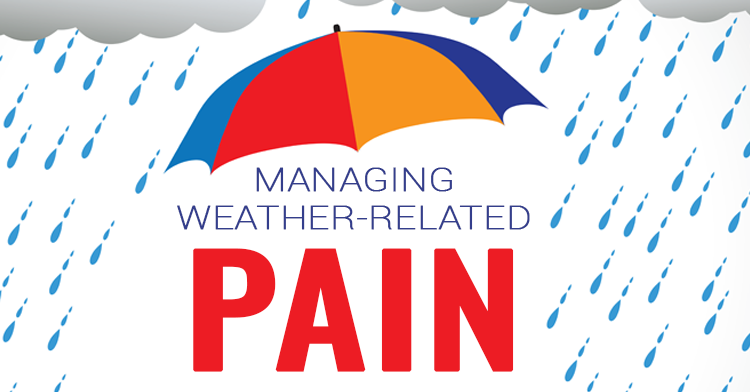Weather Changes Causing Aches and Pains?
You might have heard someone say they can “feel the weather” in their bones. Well, there’s more to this than just an expression. While the weather itself does not cause pain, changes in the weather can cause your aches and pains to flair up, especially for those who suffer from joint conditions. Many sufferers of back, neck, shoulder, or other types of joint pain can feel — or even predict! — a change in the weather as their pain increases.
Humidity can be a contributing factor. In one study, published in the journal Pain, researchers found that arthritis patients reported pain scores worsening by one point for every 10 percent increase in humidity.
The same study also showed that stormy weather can increase the effects of pain. Patients’ movement functionality worsened for every 3/10 decrease in barometric pressure. Barometric pressure decreases before a storm. The decreased pressure against the bodies can allow extra fluid to expand and push against the swollen tissue. This results in further irritation of the pain nerve fibers surrounding the already inflamed area.
Cold weather is also detrimental. A study from Tufts University found that every 10-degree drop in temperature corresponded with an incremental increase in joint pain.
And, just the physical feeling of being cold affects our posture and increases stiffness (which can lead to higher levels of pain in already impacted areas.). Hunching over, pulling your neck into your shoulders, and shivering are all difficult postures that can increase pain in the back and neck. Be aware of how you are sitting, standing, and walking as the weather cools off. Wear warmer clothes and keep your extremities covered whenever going outside. When you do get into a warmer space and your muscles begin to warm up, take a few minutes to stretch and relieve the stiffness that you may have unknowingly been experiencing.
While you can’t control the weather, you can help to curb the pain often associated with weather fluctuation. Here are a few suggestions:
- Feed your body. Take fat-soluble vitamins A, D, E, K. At every meal, try to consume a fat source. Avocados, coconut oil, olive oil for dressings, fish, and nuts are some sources of “good” fats.
- Speaking of nutrition, be mindful of foods that might upset your gut. It’s believed that a healthy gut biome can promote overall wellness. Looking at conditions like Crohn’s and ulcerative colitis, researchers have found a link between poor digestion and other inflammatory conditions like arthritis. In other words, eating foods that might aggravate the gut can cause issues in other parts of the body, like joints.
- Exercise smart. Regular, low-impact exercise has been found to help arthritis sufferers. Just be careful not do anything too strenuous and ice joints when necessary before and after exercise. Your regimen might include weight training, high-intensity exercises, cardio, stretching, and core work. Yoga is great for pain management and the mind-body connection.
As we enter a new season, keep these tips in mind. They could mean the difference between pain and relief.





